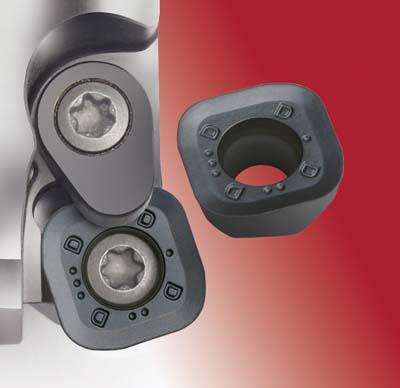
Dapra Corp. has introduced HFDEH high-feed inserts, which fit current Toroid cutter bodies. Part of Dapra's RHINO-CARB line of inserts, these new inserts are CNC-pressed, rather than ground. Because they are thicker, they are also stronger and have enhanced heat-absorption capabilities.
The HFDEH Inserts are designed for very aggressive metal cutting and long tool life, providing high metal-removal rates at lighter depths of cut. Their high-positive cutting edge is ideal for stainless steels, high-temperature alloys and gummy materials. The stronger edge of the HFDEH series allows for heavier chiploads, greater shock absorption and longer tool life. A positive top rake reduces cutting forces and lowers torque.
Dapra offers these inserts in the three tougher Toroid substrates: DMK30, DMK25, and DMP25. Suitable for 1-¼" diameters and above, the HFDEH high-feed inserts are ideal for such demanding applications as mold cavity and core roughing; roughing of complex part contours; pocketing; helical interpolation; and the roughing portion of the facemilling process.
Contact Details
Related Glossary Terms
- alloys
alloys
Substances having metallic properties and being composed of two or more chemical elements of which at least one is a metal.
- facemilling
facemilling
Form of milling that produces a flat surface generally at right angles to the rotating axis of a cutter having teeth or inserts both on its periphery and on its end face.
- rake
rake
Angle of inclination between the face of the cutting tool and the workpiece. If the face of the tool lies in a plane through the axis of the workpiece, the tool is said to have a neutral, or zero, rake. If the inclination of the tool face makes the cutting edge more acute than when the rake angle is zero, the rake is positive. If the inclination of the tool face makes the cutting edge less acute or more blunt than when the rake angle is zero, the rake is negative.
- stainless steels
stainless steels
Stainless steels possess high strength, heat resistance, excellent workability and erosion resistance. Four general classes have been developed to cover a range of mechanical and physical properties for particular applications. The four classes are: the austenitic types of the chromium-nickel-manganese 200 series and the chromium-nickel 300 series; the martensitic types of the chromium, hardenable 400 series; the chromium, nonhardenable 400-series ferritic types; and the precipitation-hardening type of chromium-nickel alloys with additional elements that are hardenable by solution treating and aging.






